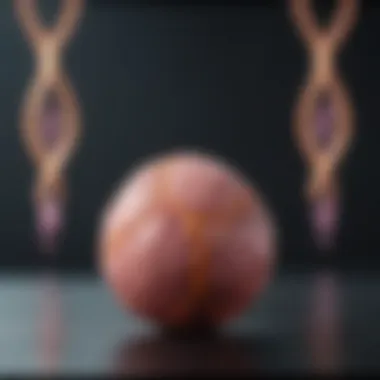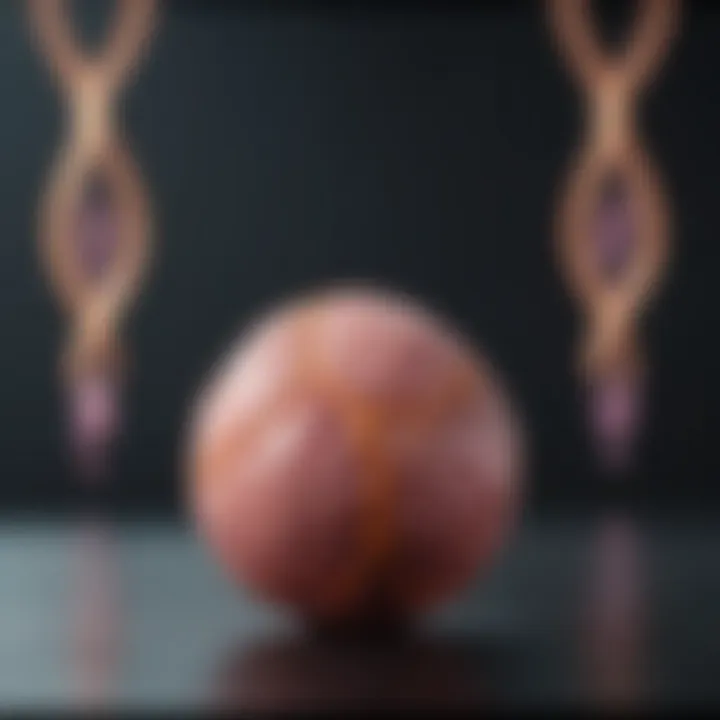Understanding the Causes of Testicular Cancer


Intro
Testicular cancer is a relatively rare, yet significant, form of malignancy that primarily affects young men. It often goes unnoticed until a later stage, which can complicate treatment outcomes. Understanding the causes behind this condition is crucial for medical professionals, researchers, and those interested in oncology. This article seeks to examine the various factors contributing to testicular cancer, focusing on biological, environmental, and genetic elements. By analyzing these aspects, we aim to provide a comprehensive view of the disease and its implications for prevention and treatment.
Article Overview
Summary of Key Findings
Recent studies have concentrated on identifying the multifaceted causes of testicular cancer. Key findings suggest that while certain genetic predispositions exist, environmental influences and hormonal factors also play a significant role. The complexity of these interactions can influence individual risk levels. Moreover, the patterns of incidence show that testicular cancer tends to be more prevalent among Caucasian males and in specific geographical regions.
Research Objectives
The objective of this article is to:
- Investigate the biological underpinnings that may predispose men to develop testicular cancer.
- Analyze environmental factors, including exposure to certain chemicals and lifestyle choices, which may elevate risk.
- Explore genetic factors, recognizing inherited conditions that might amplify susceptibility.
- Synthesize existing research to provide a clearer understanding of how these causes interact and influence incidence rates.
Key Results and Discussions
Main Findings
Analysis reveals that individuals with a family history of testicular cancer are at a higher risk. Similarly, those with specific congenital conditions, such as cryptorchidism, often show increased vulnerability. Recent data highlights that exposure to endocrine-disrupting chemicals is another vital area of concern. Further studies suggest that obesity and certain reproductive health issues may also contribute.
"The multifaceted nature of testicular cancer necessitates a comprehensive analytical approach, integrating genetic and environmental factors to grasp the complete picture."
Implications of Findings
Research continues to evolve, and ongoing inquiries into the dynamic interplay of these causes will refine our understanding, guiding future efforts in prevention and treatment. In closing, this exploration of the causes behind testicular cancer could provide an invaluable resource for those engaged in related fields.
Prologue to Testicular Cancer
Testicular cancer is a significant health issue that deserves careful consideration. Understanding this disease not only aids in early detection but also enhances awareness about its various causes. This introductory section focuses on defining the condition, exploring prevalence, and identifying factors that contribute to its development. By analyzing these aspects, readers can appreciate the complexity of testicular cancer and its impact on males of different ages.
Definition and Overview
Testicular cancer arises from abnormal cell growth in the testicles, which can disrupt normal functions. It is crucial to note that this type of cancer primarily affects young to middle-aged men, making it distinct from other cancer types that are more prevalent with age. There are different subtypes of testicular cancer. The most common include seminomas and non-seminomas. Each type exhibits unique characteristics and, consequently, different treatment responses.
Understanding the definition of testicular cancer establishes the foundation for further investigation into its causes. Recognizing that it is a potentially treatable condition if identified early encourages proactive health management among young men.
Epidemiology of Testicular Cancer
The epidemiology of testicular cancer involves examining its incidence and demographic factors. It is essential to review such data to understand who is at risk and the trends associated with this cancer type.
Incidence Rates
Incidence rates refer to the frequency of new cases within a specified population over a defined time period. Testicular cancer displays varying incidence rates across different regions and demographics. In general, the incidence of testicular cancer has been increasing in several parts of the world. This rise suggests a possible shift in environmental, lifestyle, or genetic factors contributing to the disease.
The unique feature of incidence rates is their ability to convey urgency regarding public health issues. Understanding these figures equips healthcare professionals to prioritize resources and encourage at-risk groups to undergo regular screenings. Factors such as age, family history, and even ethnicity can influence how often testicular cancer occurs, providing critical insights into prevention strategies.
Demographic Factors
Demographic factors encompass various characteristics, including age, ethnicity, and geographic location. Understanding these variables is vital for identifying populations at elevated risk for testicular cancer. For instance, it is more prevalent among Caucasian males compared to other ethnic groups, particularly in North America and Northern Europe.
The significance of demographic factors lies in their detailed analysis which enables targeted interventions. Recognizing that certain groups have higher susceptibility allows healthcare providers to develop specific education and prevention programs tailored to these demographics. One can advocate for greater awareness and screening initiatives among those identified as high-risk.
In summary, the epidemiology of testicular cancer—encompassing incidence rates and demographic factors—serves as a cornerstone for developing effective awareness and prevention strategies. By delving into these areas, we can better understand the profiles of men who may be most affected and the broader implications for public health.
Biological Mechanisms
Understanding the biological mechanisms that contribute to testicular cancer is essential for identifying its causes. These mechanisms involve complex interactions among various cellular components and genetic factors within the testes. Grasping these concepts can improve prevention strategies and develop targeted treatments.
Cellular Composition of Testes
Sertoli Cells
Sertoli cells play a crucial role in supporting and nourishing sperm cells. They are often described as "nurse" cells in the testes. One important aspect of Sertoli cells is their ability to create a blood-testis barrier, which protects developing sperm from harmful substances in the bloodstream. This barrier helps maintain a favorable environment for spermatogenesis.
What makes Sertoli cells particularly relevant to this discussion is their involvement in hormonal regulation and fertility. When there is an abnormality in Sertoli cell function, it can lead to infertility and even contribute to cancer development. These cells have unique surface receptors sensitive to hormonal changes, and their dysfunction may lead to testicular cell growth disturbances, leading to malignancies.
Sertoli cells can exhibit both advantages and disadvantages in this context. An example of a potential disadvantage is how their abnormal proliferation may result in testicular tumors.
Leydig Cells


Leydig cells are another critical component of testicular biology. These cells produce testosterone, a hormone that is vital for the development of male characteristics and reproductive functions. Understanding Leydig cells is essential because fluctuations in hormone levels can influence the growth and differentiation of testicular cells.
A key characteristic of Leydig cells is their role in homeostasis of testosterone levels. They respond to luteinizing hormone (LH), which stimulates testosterone production. When Leydig cells become dysfunctional, either due to genetic mutations or environmental factors, this can lead to hormonal imbalances. Such imbalances may contribute to conditions conducive to cancer development.
The unique feature of Leydig cells lies in their capacity to respond to various signaling pathways. Their responsiveness can present both advantages, such as maintaining healthy testosterone levels, and disadvantages, such as potentially facilitating tumor growth if they become overly activated.
Genetic Mutations
Chromosomal Abnormalities
Chromosomal abnormalities are one of the significant factors contributing to testicular cancer. These are changes in the normal structure or number of chromosomes. A notable type of chromosomal abnormality in testicular cancer is the presence of an extra chromosome, specifically the isochromosome of the short arm of chromosome 12. This abnormality is often found in patients with germ cell tumors, a common form of testicular cancer.
The importance of chromosomal abnormalities cannot be overstated, as they serve as biomarkers for risk assessment and prognosis. Their unique characteristic lies in their association with specific types of tumors, making them a valuable area of study in understanding the disease.
However, the disadvantage is that not every individual with chromosomal abnormalities will develop cancer, indicating a complex relationship between genotype and phenotype.
Oncogenes and Tumor Suppressors
Oncogenes and tumor suppressor genes play pivotal roles in regulating cell growth and preventing cancer. Oncogenes promote cell division, while tumor suppressor genes inhibit it. An example of an oncogene related to testicular cancer is KIT, known for its role in cell proliferation. In contrast, tumor suppressor genes like TP53 are critical for cell cycle regulation. Mutations in these genes can lead to uncontrolled cell growth and contribute to the development of tumors.
The significance lies in the duality of these genes; while normal function promotes healthy cellular behavior, mutations can introduce malignancies. Their unique feature is how they directly correlate with the biological mechanisms underpinning cancer development, making them integral to research and prevention strategies.
Challenges arise as targeting these pathways for treatment can be complex, given the intricacies of genetic interactions and tumor microenvironments.
Environmental Factors
Understanding environmental factors is crucial in the discussion of testicular cancer. Numerous studies suggest connections between the incidence of this type of cancer and various environmental exposures. These factors can encompass a range of influences, including chemicals and radiation. Assessing these elements helps elucidate the broader context of risk and contributes to preventive health strategies.
Chemical Exposure
As one of the significant environmental aspects, chemical exposure raises considerable interest among researchers and practitioners alike. Chemical agents can disrupt endocrine functions and may promote carcinogenesis in testicular tissue. Understanding their role is essential in grasping the multifaceted causes of testicular cancer.
Pesticides
Pesticides illustrate a critical area in environmental exposure discussions. Many pesticides are known to contain neurotoxic and endocrine-disrupting properties. This characteristic makes them beneficial for examining health risks, especially in agricultural communities. Their unique feature lies in their pervasive use, linked to agricultural productivity. However, the advantages come with significant concerns regarding their long-term health effects, potentially increasing the risk of testicular cancer.
- Key Points about Pesticides:
- They may affect hormone levels.
- Frequent exposure occurs among agricultural workers.
- Research suggests a direct link to certain cancers.
Industrial Chemicals
Another important area is industrial chemicals. These substances are used in various manufacturing processes and can include heavy metals, solvents, and plastics. Their presence in industrial settings marks them as a significant concern. Industrial chemicals are often found in higher concentrations in occupational environments, which heightens exposure risks. Their unique aspect is the diverse range of toxicological profiles they exhibit, making them both complex and hazardous. While they are essential for various products, the risks associated with long-term exposure are concerning.
- Key Points about Industrial Chemicals:
- Commonly found in industrial workplaces.
- Some studies have indicated a correlation with cancer incidences.
- The effects of long-term exposure are still being studied.
Radiation Exposure
Radiation exposure is another environmental factor that can increase testicular cancer risk. Both medical and environmental radiation have important implications. Understanding these exposures can guide appropriate exposure limits and health recommendations.
Medical Radiation
Medical radiation refers to radiation used in diagnostic and therapeutic procedures. This type of exposure can include X-rays and CT scans. While essential for medical treatment, it introduces risks when used excessively or improperly. The characteristic of medical radiation as a diagnostic tool makes it valuable for early detection of various conditions, including cancers. However, the potential downside is the cumulative dose received over a lifetime, leading to concerns over the development of testicular cancer.
- Key Points about Medical Radiation:
- Essential for diagnosis and treatment.
- Risks increase with frequent use.
- Awareness of safe practices is crucial.
Environmental Radiation
Finally, environmental radiation encompasses natural and man-made sources that can contribute to cancer risk. Radon gas is a notable example, as it can accumulate in homes, especially in certain geographical areas. Its hazardous characteristic lies in its long-term exposure risks. While environmental radiation is often lower than medical radiation, persistent exposure can be significant. Understanding this risk can aid in preventative measures and public health policy.
- Key Points about Environmental Radiation:
- Present in various forms naturally.
- Radon is a primary concern in homes.
- Monitoring levels can help manage risks.
In summary, both chemical and radiation exposures present significant environmental factors in the context of testicular cancer. Recognizing their roles can help shape future preventive strategies and research directions.
Genetic Predisposition


Genetic predisposition plays a vital role in understanding testicular cancer. This condition typically results from a combination of genetic factors that can increase an individual's risk of developing this type of cancer. Identifying these genetic influences is important for comprehending the multifactorial nature of testicular cancer and its underlying mechanisms.
Family History
Hereditary Patterns
Hereditary patterns refer to the transmission of genetic traits from parents to offspring. In the context of testicular cancer, individuals with a family history of the disease may inherit specific genetic mutations that elevate their risk. A significant aspect of these patterns is that they help in recognizing which families might be at a greater risk of developing testicular cancer.
A key characteristic of hereditary patterns is their ability to highlight the importance of genetic counseling. Individuals from families with histories of testicular cancer can benefit from such services. They provide insights on whether genetic testing is appropriate and useful. The unique feature of hereditary patterns lies in their potential to guide early detection and tailored prevention strategies.
However, the main disadvantage is that not all hereditary cases result from identifiable genetic mutations. This can make understanding the risk less straightforward for some families.
Risk in Relatives
Risk in relatives examines how familial connections affect the likelihood of developing testicular cancer. It emphasizes that men with brothers or fathers who have had testicular cancer exhibit a higher risk of also being diagnosed. This aspect aids in creating awareness around genetic predisposition and its implications for individuals with a familial background.
A notable characteristic of this concept is the accessible familial knowledge it brings. When individuals are aware of their relatives’ health histories, they can take proactive measures regarding their health. The unique benefit here is that individuals with a family history may opt for regular check-ups or screenings, potentially leading to earlier diagnosis.
On the other hand, it is important to note that while being related to someone with testicular cancer increases risk, it does not guarantee that others in the family will be affected. This uncertainty can lead to anxiety or misinterpretations of risk.
Genetic Syndromes
Genetic syndromes further illustrate the complexities associated with testicular cancer risk. These syndromes consist of specific combinations of genetic anomalies that can significantly increase an individual’s susceptibility to various cancers, including testicular cancer.
Klinefelter Syndrome
Klinefelter syndrome is one of the most recognized genetic conditions associated with increased risks of testicular cancer. This syndrome occurs when males have an extra X chromosome, leading to various developmental challenges. A key characteristic of Klinefelter syndrome is the presence of infertility and reduced testosterone levels, which can be monitored throughout an individual's life.
Considering its significance, Klinefelter syndrome is a crucial aspect of this article. Understanding its link to testicular cancer informs patients and healthcare providers about potential risks and necessary assessments. One unique feature of this syndrome is that many affected individuals may not be diagnosed until they pursue fertility treatments. Despite its qualifications, the disadvantage lies in the lack of awareness regarding testing options among those who may be affected.
Other Associated Conditions
Other associated conditions, such as androgen insensitivity syndrome and cryptorchidism, contribute to understanding genetic predispositions to testicular cancer. These conditions illustrate that beyond genetic syndromes themselves, variations in hormonal and physical development can increase vulnerability to cancer.
A beneficial aspect of discussing these conditions is the expansion of knowledge. Awareness helps underscore the urgency of monitoring those affected for testicular cancer. The unique feature here involves the intersection of hormonal and physical factors as they relate to cancer risk, highlighting the complexity of these issues.
However, the disadvantage is that the relationship between these conditions and testicular cancer can be variable, making it challenging to predict outcomes universally.Additionallly, more research is needed in these areas.
Understanding genetic predisposition can lead to better prevention and treatment strategies for those at risk.
Hormonal Influences
Hormonal influences play a significant role in the development of testicular cancer. The intricate balance of hormones not only regulates the function of the testes but also impacts the susceptibility to various conditions, including cancer. In particular, testosterone, the primary male sex hormone, is crucial in maintaining proper testicular health. The levels of this hormone are often linked to the risk factors associated with testicular cancer, making it an essential area of study.
Testosterone Levels
Testosterone levels are a key element in understanding testicular cancer. This hormone is produced by Leydig cells, which are located within the testes. After puberty, testosterone is integral for the maturation of sperm and the development of male characteristics.
Low testosterone levels may correlate with various health issues and could potentially increase the risk of developing testicular cancer. A study pointed out that men with lower testosterone levels were at a higher risk of testicular cancer compared to those with normal ranges. Maintaining appropriate testosterone levels not only supports reproductive health but may also be protective against certain malignancies.
Lifestyle factors, such as diet and exercise, can influence testosterone levels. Engaging in regular physical activity and consuming a balanced diet rich in nutrients can bolster hormone levels. Moreover, regular health check-ups can help assess hormone levels and detect any irregularities early.
Impact of Hormonal Imbalances
Hormonal imbalances can lead to various health problems, one of which may include an increased risk of testicular cancer. When hormones are out of balance, especially during critical developmental periods, the regulation of cellular growth in the testes may be disrupted.
Conditions such as hypogonadism or disorders affecting the hypothalamus and pituitary gland can directly influence testosterone production and lead to dysfunction. These disorders associated with hormonal imbalance can predispose the individual to an environment conducive to cancer development.
Additionally, other endocrine disorders affecting hormonal levels can have cascading effects on various bodily systems, leading to complications that could contribute to the risk of cancer. Recognizing and addressing hormonal imbalances through proper medical intervention is of utmost importance. This ensures the restoration of normal hormonal levels and consequently may reduce the potential risk linked with testicular cancer.
"Proper hormonal regulation is crucial for optimal testicular health and may influence the risk of developing testicular cancer."
Congenital Conditions
The study of congenital conditions provides insight into how developmental issues can predispose males to testicular cancer. One of the critical considerations is the identification and awareness of these abnormalities. Healthcare professionals need to educate families about congenital conditions and their possible implications.
Cryptorchidism
Cryptorchidism is one of the most studied congenital conditions associated with testicular cancer. In this condition, one or both testicles fail to descend into the scrotum before birth. The incidence of cryptorchidism varies. It affects about 1 in 100 boys. This condition is more common in premature babies.
The complicating factor here is that boys with a history of cryptorchidism have a much higher risk of developing testicular cancer later in life. The exact mechanisms are not fully understood, but it is believed that the abnormal location of the testicles may interfere with normal hormonal function and testicular development.


"Boys with a history of cryptorchidism may face an increased risk of testicular cancer, highlighting the need for early diagnosis and potential treatment options."
Regular follow-ups and potential surgical options such as orchidopexy are vital in managing cryptorchidism. This procedure aims to reposition the testicles into the scrotum and may reduce cancer risk, although the benefits can vary depending on individual circumstances.
Other Birth Defects
In addition to cryptorchidism, other congenital anomalies may contribute to the risk of testicular cancer. Conditions such as hypospadias, where the urethra does not fully develop, and various hormonal disorders can also have implications. Boys born with these conditions should be closely monitored as they grow.
Some studies suggest a correlation between certain birth defects and increased cancer risk, but research is less defined than for cryptorchidism. Ongoing investigations aim to uncover these relationships and better understand how various congenital defects influence hormonal levels and development.
Many congenital conditions can be identified early, allowing for timely intervention and monitoring. Parents should consult with healthcare professionals regarding any concerns related to congenital conditions, ensuring proactive healthcare approaches.
Preventive Measures
The significance of preventive measures in the realm of testicular cancer cannot be overstated. As awareness of this form of cancer grows, it becomes increasingly clear that proactive steps can pave the way for earlier detection and potentially more effective treatment. Through regular health check-ups and heightened awareness and education, individuals can position themselves favorably against the risks associated with this disease.
Regular Health Check-ups
Regular health check-ups serve as a cornerstone of preventive health strategies. These sessions provide ample opportunities for healthcare professionals to monitor individuals for signs or symptoms of testicular cancer. Many cases of testicular cancer are detected early during these routine examinations, thereby increasing survival rates.
- Regular check-ups typically include:
- Visual and physical examinations of the testes.
- Discussions about any noticeable changes or concerns.
- Educational components about self-examination techniques.
Men need to be diligent about these examinations, especially those in higher-risk groups, such as men aged 15 to 35. By making regular appointments with healthcare providers, men can significantly reduce the risk of late-stage diagnosis. Early detection often correlates with better treatment outcomes, reinforcing the value of preventative care in this context.
Awareness and Education
Awareness and education play crucial roles in preventive measures concerning testicular cancer. Knowledge empowers individuals to take charge of their health effectively. It is important for men to be aware of their bodies and any changes that may occur.
- Education efforts should include:
- Information on risk factors associated with testicular cancer.
- Guidance on how to conduct self-examinations at home.
- Resources for support and information such as educational websites, health fairs, and community outreach programs.
Raising awareness within communities can demystify the subject of testicular health, encouraging open dialogue and proactive behavior. Educational initiatives may help men recognize symptoms early on, prompting timely medical visits. Data gathered from recent studies show that men who are informed about symptoms and risk factors are more likely to seek medical advice when necessary, thereby enhancing their chances of early detection.
"Empowering individuals through knowledge is a key strategy in decreasing incidence rates of testicular cancer."
Current Research Trends
Research in testicular cancer is evolving rapidly. Understanding these trends is crucial for students, researchers, and healthcare professionals. Ongoing studies are uncovering new insights into the etiology of the disease, leading to better prevention and treatment strategies. As we develop a better grasp of the various causes of testicular cancer, the focus shifts towards optimizing patient care based on the latest scientific findings.
Key elements of current research trends include the examination of novel biomarkers, the impact of environmental exposures, and advancements in genetic studies. These areas play a vital role in enhancing the understanding of this cancer type whilst presenting opportunities for targeted interventions.
New Discoveries
Recent studies have revealed several significant discoveries related to testicular cancer. One notable finding concerns the role of microRNAs in cancer progression. MicroRNAs are small, non-coding RNA molecules that regulate gene expression. Alterations in these molecules may contribute to the development of testicular tumors. Researchers are currently exploring how targeting these microRNAs could open new avenues for therapy.
Moreover, genetic factors continue to take center stage. For instance, researchers have identified specific single nucleotide polymorphisms (SNPs) linked to an increased risk of testicular cancer. These findings enhance understanding of individual susceptibility and may assist in developing risk assessment tools for early diagnosis.
Future Directions in Research
Looking ahead, several directions appear promising for advancing testicular cancer research. First, there is a growing interest in exploring the effects of epigenetic modifications. These alterations can influence gene expression without changing the DNA sequence and may provide insights into how environmental factors interact with genetic predispositions.
Additionally, the integration of artificial intelligence and machine learning techniques are emerging as pivotal components in cancer research. These technologies can analyze vast datasets, revealing patterns and risk factors that might otherwise go unnoticed. By leveraging AI tools, researchers aim to improve prediction models and personalizing treatment strategies.
"Current research not only sheds light on the biological underpinnings of testicular cancer but also paves the way for innovative approaches in treatment and management."
Ultimately, these trends signify the potential for transformative advancements in understanding and addressing testicular cancer, steering the field towards more nuanced and effective healthcare solutions.
Epilogue
The exploration of testicular cancer and its varied causes presents several significant insights into the ongoing challenges of diagnosis and treatment. Understanding these causes is paramount not only for advancing medical knowledge but also for improving preventive strategies. As we continue to deepen our comprehension of the intricate interplay between biological, environmental, and genetic factors, we stand to make informed decisions that can aid in minimizing the risk associated with this type of cancer.
Summary of Causes
Testicular cancer emerges from a complex integration of factors:
- Biological Factors: The cellular composition of the testes, notably Sertoli and Leydig cells, plays a crucial role. Genetic mutations, particularly chromosomal abnormalities and alterations in oncogenes or tumor suppressors, are also significant contributors.
- Environmental Influences: Exposure to specific chemicals such as pesticides and industrial substances can increase the likelihood of developing testicular cancer. Furthermore, both medical and environmental radiation exposure have raised concerns regarding their long-term effects on testicular health.
- Genetic Predisposition: A family history of testicular cancer often indicates hereditary patterns that elevate risk levels. Specific genetic syndromes, like Klinefelter syndrome, are correlated with higher incidences of testicular malignancies.
- Hormonal Factors: The interplay of testosterone levels and hormonal imbalances is essential in understanding risk factors involved in testicular cancer.
- Congenital Conditions: Conditions arising from birth defects, such as cryptorchidism, are notable risk factors that warrant attention.
- Preventive Measures and Current Research: Ongoing research continuously uncovers new patterns and risk factors. Regular health checkups and education can aid in early detection and increase awareness about preventive strategies.
Implications for Future Health Approaches
Understanding the multifactorial nature of testicular cancer is vital for developing future health policies. Emphasis on early detection and preventive measures can lead to better outcomes for patients.
Continued research is needed to enhance the comprehension of cancer biology, identifying specific environmental triggers and ensuring equitable access to treatment options. Educational programs outlining the risk factors and encouraging regular health checkups can foster proactive health approaches among at-risk populations.
Moreover, improved genetic screening and counseling can inform individuals about their risk, leading to informed decision-making regarding screening and lifestyle choices. The integration of technological advancements in monitoring and diagnosing testicular cancer holds promise. As we enhance our understanding of this cancer's causes, we can aspire to mitigate its impact fully.







